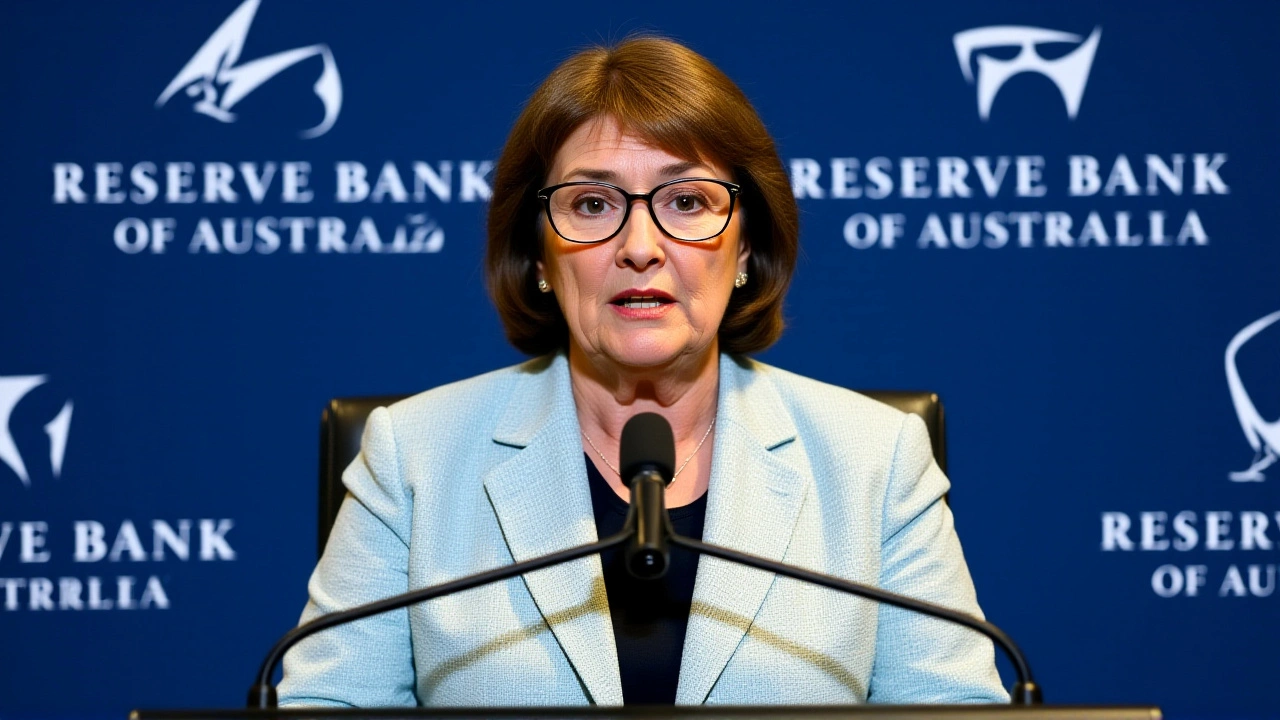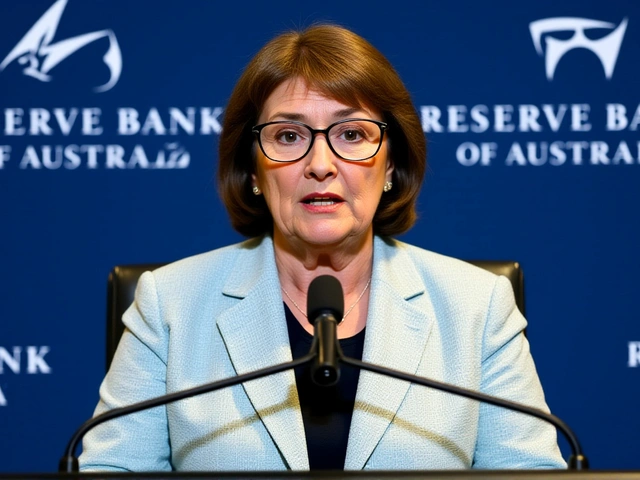The Reserve Bank of Australia delivered its first interest rate cut in over two years on Tuesday, November 18, 2025, lowering the cash rate from 4.10% to 3.85% — a move that signals growing confidence inflation is finally under control. Governor Michele Bullock, speaking at the RBA’s headquarters at 65 Martin Place, Sydney, didn’t celebrate. Not yet. "Inflation is now below three per cent and employment is holding up," she said. "But we must keep it there." The decision, announced at 2:30 PM AEDT, came after core inflation dropped to 2.9% for the year to March 2025 — the first time it’s been inside the RBA’s 2–3% target band since December 2021. The twist? The economy isn’t coasting. It’s walking a tightrope.
Why This Cut Wasn’t a Given
For months, markets expected a cut. But Bullock held firm. In October, the RBA kept rates steady at 4.10%, citing insufficient evidence inflation was "sustainably" in target. Then came the March quarter data: headline inflation at 3.4%, core inflation at 2.9%. Wage growth softened to 3.7% — down from a peak of 4.5% in 2023. Unemployment held at 4.1% in October, still tight by historical standards. The central bank’s own models showed financial conditions had eased naturally, thanks to falling loan spreads, not just rate cuts. "The neutral rate has trended lower," Assistant Governor Sarah Hunter noted in her October speech. "We’re not in the 4.5% world of the 1990s anymore." That’s why the cut was just 25 basis points — not 50. "The labour market remains tight," said Shane Oliver, chief economist at AMP Limited. "Productivity hasn’t improved. And if US tariffs resume, it’ll hit jobs hard. A bigger cut would’ve been reckless."The Narrow Path Is Retired — But the Cliff Is Still There
Bullock dropped a phrase that defined her tenure: the "narrow path." For months, she’d warned the RBA was walking a thin line between taming inflation and triggering unemployment. Now, she said, it’s time to retire the analogy. "We’re always going to be thrown off course by things," she admitted. "The next year is going to be a really interesting time. It’s a complete different shock." That shock? Geopolitics. Trade tensions are simmering. The US has paused new tariffs, but they could return. Australia’s export-dependent sectors — education, agriculture, mining — are watching closely. Meanwhile, household debt remains a ticking clock. As of September 2025, the debt-to-income ratio hit 189%. Thirty-two percent of variable-rate mortgage holders are now spending over 30% of their income on repayments, according to the Australian Prudential Regulation Authority. That’s not crisis territory yet. But it’s not comfortable either.What the Numbers Don’t Tell You
The RBA’s November Statement on Monetary Policy projects inflation will stay in target through 2026. GDP growth is expected to edge up from 1.8% in 2025 to 2.3% in 2026. Unemployment? It’ll creep to 4.4% by year-end. That’s still low. But it’s a warning sign. When unemployment rises, it’s usually because companies are pulling back. And if they’re pulling back, it’s because demand is fading. The real puzzle? Productivity. It hasn’t budged. Wages are falling, but costs aren’t. That’s why inflation hasn’t collapsed further. Businesses aren’t raising prices because they can’t — not with weak demand in retail and construction. But they’re not cutting wages either. The result? A stalemate. And that’s why Bullock’s team isn’t declaring victory.
What Comes Next?
The next RBA meeting is December 16, 2025. Markets are pricing in another 25-basis-point cut. But Bullock made it clear: no automatic path. "We’ll be guided by data, not forecasts," she said. The next CPI report drops in early December. If it shows inflation ticking up again — even to 3.1% — the cut could be paused. Meanwhile, households are breathing easier. A 0.25% cut saves the average variable-rate homeowner about $35 a month. Not life-changing. But enough to help. Still, with 12 consecutive hikes between May 2022 and November 2023, many Australians are still recovering. Some are still paying off credit card debt from the peak. Others are delaying home renovations, car purchases, even dental work. The RBA’s job isn’t done. It’s just changed.Background: The Long Road Back
When Bullock took over as Governor in September 2023, the cash rate was at 4.35% — the highest in 12 years. The RBA had hiked rates 12 times in 18 months to crush inflation that hit 7.8% in 2022. Families felt it. Renters saw rents jump 15% in Sydney alone. Small businesses shuttered. The economy nearly stalled. The pivot began in September 2025, when the RBA cut rates for the first time since June 2023 — from 4.35% to 4.10%. That was a signal. This cut is the confirmation. Bullock’s leadership has been defined by caution. Unlike her predecessor, Philip Lowe, who sometimes sounded optimistic too soon, she’s been methodical. She’s listened to economists, bank analysts, and even small business owners. She didn’t rush. And now, with inflation in target, she’s still not letting up.Frequently Asked Questions
Why did the RBA cut rates by only 25 basis points instead of 50?
The RBA opted for a cautious 0.25% cut because while inflation is in target, the labour market remains tight, productivity is stagnant, and global trade risks are rising. A larger cut could’ve overheated demand again. AMP’s Shane Oliver noted that wage growth has softened to 3.7%, and financial conditions have already eased due to lower loan spreads — meaning less aggressive monetary easing was needed.
How does this affect mortgage holders?
The 0.25% cut reduces monthly repayments by roughly $35 for the average variable-rate homeowner with a $500,000 mortgage. That’s welcome relief after 12 straight hikes. But with 32% of borrowers spending over 30% of income on mortgages — and household debt at 189% of income — many are still under severe financial strain. This cut helps, but it doesn’t fix the underlying affordability crisis.
Is inflation really under control?
Core inflation is back in the 2–3% target range for the first time since 2021, and headline inflation is falling. But the RBA warns it’s not "slayed." Wage growth remains above 3%, and global supply shocks — like renewed US tariffs — could push prices up again. The bank is watching services inflation closely, which is still sticky due to high labour costs.
What’s the risk of unemployment rising too fast?
The RBA expects unemployment to rise to 4.4% by December 2026. That’s still low historically, but a faster rise could signal weakening demand. With productivity flat, businesses aren’t investing in automation or expansion — meaning job losses could come quickly if consumer spending slows. Bullock’s biggest fear isn’t inflation returning — it’s a jobs crash triggered by global trade disruption.
What’s the outlook for interest rates in 2026?
The RBA forecasts inflation will stay in target through 2026, with GDP growth picking up to 2.3%. Markets expect one or two more 25-basis-point cuts by mid-2026, but Bullock has signaled no preset path. The next move depends on US trade policy, wage data, and whether household spending rebounds. If inflation creeps up, the RBA won’t hesitate to pause or even reverse course.
Why is Michele Bullock’s leadership different from Philip Lowe’s?
Bullock has been far more data-driven and less optimistic in public messaging. While Lowe declared inflation "on the way down" too early in 2023, Bullock waited for clear, sustained evidence. She’s also more transparent about risks — frequently warning of geopolitical shocks and labour market fragility. Her cautious tone reflects her background as a former bank executive, not an academic economist.


